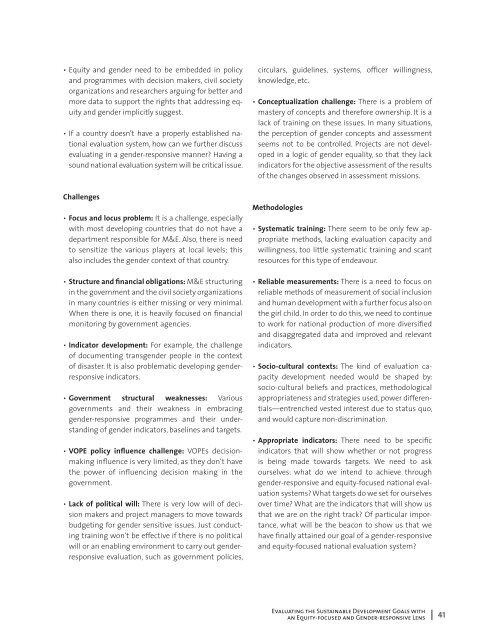NO ONE LEFT BEHIND
NY-Events-Report_WEB
NY-Events-Report_WEB
Create successful ePaper yourself
Turn your PDF publications into a flip-book with our unique Google optimized e-Paper software.
••<br />
Equity and gender need to be embedded in policy<br />
and programmes with decision makers, civil society<br />
organizations and researchers arguing for better and<br />
more data to support the rights that addressing equity<br />
and gender implicitly suggest.<br />
••<br />
If a country doesn’t have a properly established national<br />
evaluation system, how can we further discuss<br />
evaluating in a gender-responsive manner? Having a<br />
sound national evaluation system will be critical issue.<br />
Challenges<br />
••<br />
Focus and locus problem: It is a challenge, especially<br />
with most developing countries that do not have a<br />
department responsible for M&E. Also, there is need<br />
to sensitize the various players at local levels; this<br />
also includes the gender context of that country.<br />
••<br />
Structure and financial obligations: M&E structuring<br />
in the government and the civil society organizations<br />
in many countries is either missing or very minimal.<br />
When there is one, it is heavily focused on financial<br />
monitoring by government agencies.<br />
••<br />
Indicator development: For example, the challenge<br />
of documenting transgender people in the context<br />
of disaster. It is also problematic developing genderresponsive<br />
indicators.<br />
••<br />
Government structural weaknesses: Various<br />
governments and their weakness in embracing<br />
gender-responsive programmes and their understanding<br />
of gender indicators, baselines and targets.<br />
••<br />
VOPE policy influence challenge: VOPEs decisionmaking<br />
influence is very limited, as they don’t have<br />
the power of influencing decision making in the<br />
government.<br />
••<br />
Lack of political will: There is very low will of decision<br />
makers and project managers to move towards<br />
budgeting for gender sensitive issues. Just conducting<br />
training won’t be effective if there is no political<br />
will or an enabling environment to carry out genderresponsive<br />
evaluation, such as government policies,<br />
circulars, guidelines, systems, officer willingness,<br />
knowledge, etc.<br />
••<br />
Conceptualization challenge: There is a problem of<br />
mastery of concepts and therefore ownership. It is a<br />
lack of training on these issues. In many situations,<br />
the perception of gender concepts and assessment<br />
seems not to be controlled. Projects are not developed<br />
in a logic of gender equality, so that they lack<br />
indicators for the objective assessment of the results<br />
of the changes observed in assessment missions.<br />
Methodologies<br />
••<br />
Systematic training: There seem to be only few appropriate<br />
methods, lacking evaluation capacity and<br />
willingness, too little systematic training and scant<br />
resources for this type of endeavour.<br />
••<br />
Reliable measurements: There is a need to focus on<br />
reliable methods of measurement of social inclusion<br />
and human development with a further focus also on<br />
the girl child. In order to do this, we need to continue<br />
to work for national production of more diversified<br />
and disaggregated data and improved and relevant<br />
indicators.<br />
••<br />
Socio-cultural contexts: The kind of evaluation capacity<br />
development needed would be shaped by:<br />
socio-cultural beliefs and practices, methodological<br />
appropriateness and strategies used, power differentials—entrenched<br />
vested interest due to status quo,<br />
and would capture non-discrimination.<br />
• • Appropriate indicators: There need to be specific<br />
indicators that will show whether or not progress<br />
is being made towards targets. We need to ask<br />
ourselves: what do we intend to achieve through<br />
gender-responsive and equity-focused national evaluation<br />
systems? What targets do we set for ourselves<br />
over time? What are the indicators that will show us<br />
that we are on the right track? Of particular importance,<br />
what will be the beacon to show us that we<br />
have finally attained our goal of a gender-responsive<br />
and equity-focused national evaluation system?<br />
Evaluating the Sustainable Development Goals with<br />
an Equity-focused and Gender-responsive Lens 41


